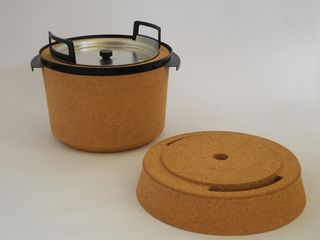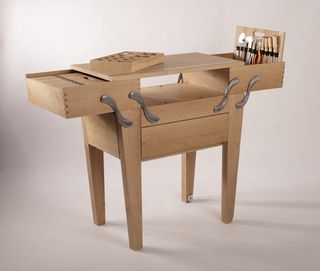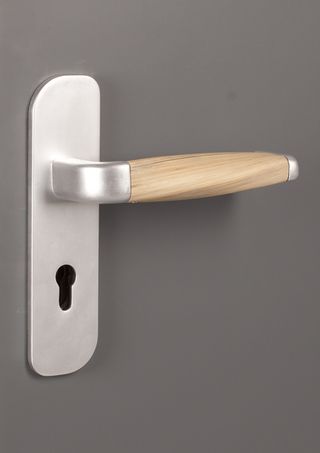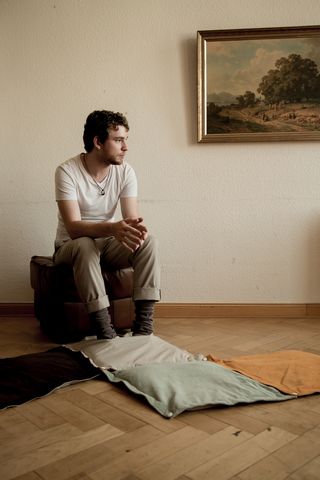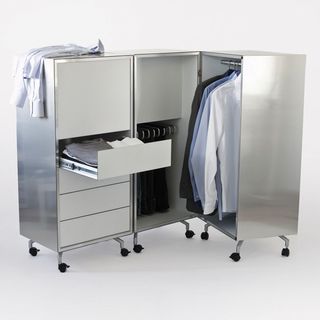»Sheep's bit« by Anna-Maria Bahr
Wool as a domestic raw material
The thesis deals with three factors. The aim was to not only boost the image of wool with consumers but also to demonstrate the broad and versatile usability of this raw material. WOOL MANUFACTURE - The Manufacture holds all steps of the wool processing. That way it is possible to provide a completely transparent value-added process. SHEEP'S BIT / PRODUCT- Wool is ideally suitable for indoors because of its natural, sustainable and technological structure. MATERIAL DEVELOPMENT - Combining wool and caoutchouc gives us a natural alternative to foam materials.
»Slowmo« by Maximilian Schmahl
Cookware for home & on the go
Slowmo is a cook tool for the kitchen at home, at work or on the go. The food is placed on the stove for a short time and then stir-cook in the heat-insulating sheath made of cork. Now it simmers for several hours. Therefore no further energy and no further work is needed. This method can prepare dishes without much effort and very energy efficient, and it can be consumed at a later date, and at another place.
»Selma« by Christina Römhild
The workbench for the living space
By removing the workbench from the workshop and integrating it in the context of the living space, an inspirational source is made for our everyday life. That way the opportunity is created to do handcraft workings without having an own workshop or basement hobby room. This concept should sensitize, inspire and support for the "DIY" movement as well as bring the positiv effects of handcraft working to awareness.
»Consumptioncreativity« by Jens Krauße
Possession – sharing - investment
This masterthesis shows possibilities how we can kreate products without destroying the material we used. The most important is that the materials we used can be seperated at the end of a product-life. The Materials have to be clean so we can use them for several products.
»Black on white« by Jenni-Fee Hahn
Time for writing
In today's society handwriting has become less important. The “black on white” writing supply would like to counter this trend. Handwriting should be given a new home in our fast paced society – the café. All effort is taken away because the guests are supplied with the proper ingredients: A good pen, a clipboard, assorted paper and a post box that saves a trip to the post office. Thus handwriting is given a contemporary home while a harmonious combination of writing and an enjoyable café atmosphere is created.
»Baltic sea & Imprint« by Teresa Becker
Study of the stimulation of the sense of touch
What is the role of our senses in today's information culture? Our daily routines are characterized by media and technological devices, which creates a domination of cognitive experience. Considering findings in the field of neuroscience about the plasticity of our brain and our skills, I have designed objects that reveal and exploit bodily potentials. The carpet designs stimulate the sense of touch, particularly the sensors and motor skills of feet, and thus the locomotor system. The use has a healthy impact and offers a physical experience.
»Kara Fee« by Laura Jahnke
An offer of service to companies
The coffee maker is part of a service concept. It allows companies to provide a coffee break to their employees in which they enjoy the experience of percolating coffee by their own hand. The tool is easy to use and ensures individual consumption of coffee. The preparation becomes a sensuous and transparent experience to the user. The situation also provides time for communication and exchange. The result is high quality coffee, a treat for all senses.
»Green H2Ouse« by Johannes Dau
Cultivation on the window sill
In Germany we use over 4000 l of water per day: not only real but also virtual water.This is the water we use to manufacture our food and products. It‘s invisible to us. It also defines the water footprint, a big science field for a responsible use of water. The Green H2Ouse is a miniture green house with an internal water circuit. Its purpose is to impart the topic and the value of our food to students through the cultivation of vegetables.
»Kooky« by Nadine Jentsch
The growing bicycle for children
„kooky“ is a bicycle that grows with the child. Among its extraordinary shape and design that is very suitable for children, its characteristics are an unique design concept and an enormous light weight. This children’s bicycle is a true innovation in the bicycle market. At the beginning „kooky“ should be used as a training bike and later on it can be transformed into a bicycle.
„kooky“ is offered in a white finish that invites the child to customize its own bike either by sticken the included reflecting stickers to the frame or even by drawing sth. on it.
»Food locker« by Nadin Jahn
The „Speiseschrank“ represents the modern equivalent of the pantry and provides a place for all the food which should not be stored in the fridge. These include especially cold-sensitive fruits and vegetables such as zucchini, potatoes and tropical fruit. The principle of evaporative cooling ensures optimal storage conditions to provide a cool and humid clima. Under these conditions the fruits and vegetables stay longer fresh and food waste can be avoided.
»Design for ability« by Valerie Stephani
Disability, inclusion and participation
The project was about designing a guidance system with different interaction points for a barrierfree recreation area. Center of the recreation area is a home for disabled people placed on an old farm house in the counrtryside. In a participatory design process different options for orientation and interaction where developed with people who live and work in the home for disabled people. The results of the workshop were the basis for the design of the guidance system.
»Old manor A. Borsig - Exhibition design« by Elisabeth Kaufmann
The task was to generate a concept for a permanent exhibition about agriculture and nutrition at the old manor A. Borsig near Berlin. Beside attending the content-related development, I created an ambitious exhibition concept for the entire heritage-protected building.The tour through 17 different rooms on 1,860 square meters, is showing correlation and connections within the topic and creating a valuable stay for every visitor. Expected opening date is Spring 2013.
»1///5 - one Five« by Dominic Heiße
Time to grill
The object brings barbecues back to common space. The BBQ master has eye contact with the rest of the group while doing his job. The grill is designed for occasional as well as hobby grillmasters. Additionally, a small integrated chimney facilitates the ignition of the charcoal. It is possible to change the materials to adapt the entire station to the natural conditions of it‘s surrounding. This makes the barbecue also perfect for campsites, campus, and private gardens.
»COUCH *Composition Of Unused Cutting Holdovers« by Joana Greulich
A resource-conserving seating furniture
COUCH* is manufactured from renewable raw materials and upholstered with modules which are made of cutting holdovers from the upholstery and mattress industry. The cushion modules can be combined flexible and replaced, customized and repaired by just a few handholds. So it is a variable companion for life! The modifiable structure of different sized and coloured modules effect an unique look. Each COUCH* is a composition of your own style.
»KON.TAKT« by Luise Dettbarn
Furniture that Connects
Each commode is placed in the living quarters of each partner who is in a long-distance relationship. It is a communication piece, which connects the partners in new ways. The objects transfer information through an internet connection, so that you can knocked at the complementary piece, open a drawer, messages can be left in the small drawers and information about the far-away partners surroundings can be related. This is a practical piece of furniture, as partners can utilize the empty drawers while visiting.
»Alu Need« by Moritz von Helldorff
Furniture for small spaces
This multifunctional piece of furniture combines a secretary, a shelf and a folding table with a closet. It is designed to hold the clothes of an average German man. The three main elements are mounted on wheels, this allows a flexible positioning. They can be easily disassembled and are therefore handy in case of a move. „Alu Need“ is made from aluminum Dibond, a composite material that is extremely lightweight while being impressively strong at the same time.
»Plenty Pots« by Holger Eichinger
Plants in the habitat of man
Consciously or unconsciously, having plants in his environment is a desire for every human being. But care and space are limiting factors.The planting system PlentyPots provides the opportunity to host a lot of plants even in small rooms because the plants are positioned above the desk‘s edge or on walls, where they do not interfere with somebody.
An integrated water reservoir nourishes the plants via a thread over a long period. The water storage prolongs watering intervals and diminishes the maintenance.
»Piece of jewellery« by Emilija Cizeika
A second skin
People have been designing and decorating their bodies and skin since the dawn of mankind. Over time the characteristics of the skin adornment have changed. This piece of jewellery symbolises the flexible structure of human skin, which is stretched, pierced and injured and thus becomes jewellery. Moreover it shows how people deal differently with their skin. The design detaches the adornment from the skin and thereby the jewellery is no longer bound to one‘s own skin.
»Fiella« by Elizabeth Jöcker
Chair for public spaces
The Fiella Chair is well-known for the contrast of the two outstanding materials of the chair and its concept of the deformation of a laminate. The chair‘s construction is based in the folding of a two-dimensional material, as an aluminum sheet and the contrast with a smoother material like felt to make it comfortable and soft. Felt also counteracts the cold effect metal can have in furniture. Fiella can be used in the open air, thanks to its water-resistant material and the removable felt covering. The removing of the covering is very simple, as is the fitting of it on the chair again. The chair can be stacked and thanks to its material is very light. So its storage is very easy, what makes it very appropriate for use In both public and private applications.The materials of the chair can be recycled and the chair itself is made of low environmental impact materials.

